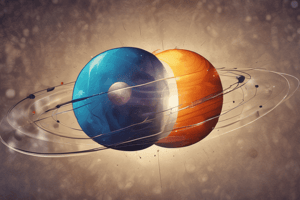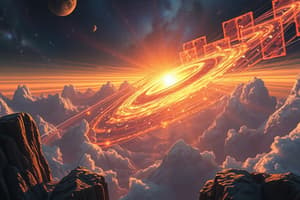Podcast
Questions and Answers
Forces change an object's motion by changing its ______, its _________, or both.
Forces change an object's motion by changing its ______, its _________, or both.
speed; direction
Only _____________ forces can change the velocity of an object.
Only _____________ forces can change the velocity of an object.
unbalanced
You know unbalanced forces are acting on an object that is at rest when the object starts ___________.
You know unbalanced forces are acting on an object that is at rest when the object starts ___________.
moving
Unbalanced forces change the ________ of a moving object. If a net force acts on a moving object in the direction that the object is moving, the object will _______.
Unbalanced forces change the ________ of a moving object. If a net force acts on a moving object in the direction that the object is moving, the object will _______.
Another way unbalanced forces can change the velocity of a moving object is to change the __________ of the object's motion.
Another way unbalanced forces can change the velocity of a moving object is to change the __________ of the object's motion.
The force of gravity acts on a ball that is thrown by changing the direction of the ball, pulling it ___________.
The force of gravity acts on a ball that is thrown by changing the direction of the ball, pulling it ___________.
Another name for change in velocity over time is ____________.
Another name for change in velocity over time is ____________.
Unbalanced forces can make an object accelerate by changing the object's _______, ________, or both.
Unbalanced forces can make an object accelerate by changing the object's _______, ________, or both.
According to ____________________, the acceleration of an object is equal to the net force acting on the object divided by the object's mass.
According to ____________________, the acceleration of an object is equal to the net force acting on the object divided by the object's mass.
The direction of acceleration is the same as the direction of the ____________.
The direction of acceleration is the same as the direction of the ____________.
The units for Newton's second law are SI units- force is measured in ______________; mass is measured in _______________; acceleration is measured in _________________.
The units for Newton's second law are SI units- force is measured in ______________; mass is measured in _______________; acceleration is measured in _________________.
One newton is the same as one ________.
One newton is the same as one ________.
________________ is any motion in which an object is moving in a curved path.
________________ is any motion in which an object is moving in a curved path.
________ causes objects to tend to move along a straight path.
________ causes objects to tend to move along a straight path.
In circular motion, a force that acts perpendicular to the direction of motion toward the center of the curve is called a (n) _____________________
In circular motion, a force that acts perpendicular to the direction of motion toward the center of the curve is called a (n) _____________________
An object that is moving in a circle accelerates in the ______________ of the centripetal force.
An object that is moving in a circle accelerates in the ______________ of the centripetal force.
Any object that circles a larger object is called a (n) ______________.
Any object that circles a larger object is called a (n) ______________.
Satellites move in a circle because a (n) __________ acts on them.
Satellites move in a circle because a (n) __________ acts on them.
_________ is the centripetal force that acts on satellites by continuously changing their direction of motion; this results in _____________ motion.
_________ is the centripetal force that acts on satellites by continuously changing their direction of motion; this results in _____________ motion.
Earth's ________ keeps the Moon in orbit around Earth.
Earth's ________ keeps the Moon in orbit around Earth.
The planets remain in orbit because the ______ gravity pulls on them.
The planets remain in orbit because the ______ gravity pulls on them.
Flashcards
Unbalanced forces affect...
Unbalanced forces affect...
Unbalanced forces cause a change in an object's speed or direction, or both.
Object at rest, forces?
Object at rest, forces?
An object at rest starts moving when an unbalanced force acts upon it.
Unbalanced force & velocity
Unbalanced force & velocity
Unbalanced forces can alter the velocity (speed and direction) of a moving object.
Gravity's effect on a ball
Gravity's effect on a ball
Signup and view all the flashcards
Acceleration
Acceleration
Signup and view all the flashcards
Acceleration & Forces
Acceleration & Forces
Signup and view all the flashcards
Newton's second law equation
Newton's second law equation
Signup and view all the flashcards
Force direction & acceleration
Force direction & acceleration
Signup and view all the flashcards
Force units
Force units
Signup and view all the flashcards
Circular motion
Circular motion
Signup and view all the flashcards
Inertia
Inertia
Signup and view all the flashcards
Centripetal force
Centripetal force
Signup and view all the flashcards
Circular motion acceleration
Circular motion acceleration
Signup and view all the flashcards
Satellite
Satellite
Signup and view all the flashcards
Satellite's motion
Satellite's motion
Signup and view all the flashcards
Gravity and satellites
Gravity and satellites
Signup and view all the flashcards
Moon's orbit
Moon's orbit
Signup and view all the flashcards
Planets and gravity?
Planets and gravity?
Signup and view all the flashcards
Study Notes
Forces and Motion
- Forces alter an object's motion by modifying its speed, direction, or both.
- Only unbalanced forces can influence the velocity of an object.
- An object at rest begins moving when unbalanced forces act upon it.
- Unbalanced forces can change the velocity of a moving object; if the net force is in the direction of motion, the object will speed up.
- The direction of a moving object's velocity can also be changed by unbalanced forces.
Gravity and Acceleration
- The force of gravity affects a thrown ball by pulling it downward.
- The term for change in velocity over time is called acceleration.
- Unbalanced forces can cause acceleration by altering an object's speed, direction, or both.
Newton's Laws and Measurement
- According to Newton's second law of motion, acceleration is the net force acting on an object divided by its mass.
- The direction of acceleration aligns with the direction of the net force.
- SI units for measurement: force is in newtons, mass is in kilograms, and acceleration is in meters per second squared.
Circular Motion
- Circular motion describes any motion where an object travels in a curved path.
- Inertia causes objects to retain straight-line motion unless acted upon by a force.
- A force acting perpendicular to the motion direction, aimed toward the center of the curve, is called centripetal force.
- An object in circular motion accelerates in the direction that the centripetal force pulls.
Satellites and Gravity
- Objects that orbit around a larger object are termed satellites.
- Satellites maintain circular motion due to the influence of centripetal force.
- Gravity serves as the centripetal force acting on satellites, continuously altering their direction to create circular motion.
- The Moon's orbit around Earth is sustained by Earth's gravity.
- The planets remain in orbit due to the sun's gravity exerting a pulling force on them.
Studying That Suits You
Use AI to generate personalized quizzes and flashcards to suit your learning preferences.




